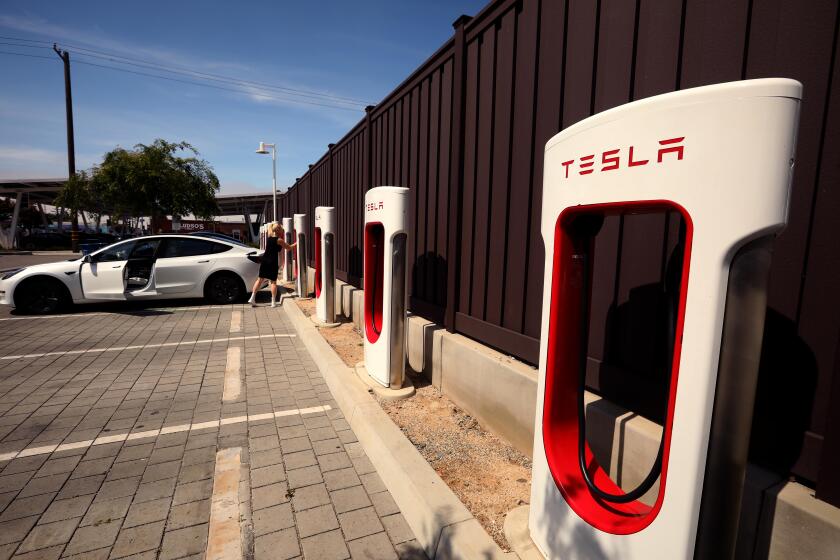GM Settles Odor Violations by Paying $45,225 to Air Board
General Motors Friday paid $45,225 to the South Coast Air Quality Management District to settle dozens of odor citations issued to the company’s Van Nuys assembly plant, air-district officials said.
The agreement comes six weeks after a series of related air-pollution charges were settled in a plea bargain between GM and the Los Angeles city attorney’s office. In that agreement, the auto maker pleaded no contest to seven misdemeanor charges and paid $11,900.
Those seven counts and the 47 citations settled Friday all stemmed from plant operations between August, 1985, and July of this year.
The odor problem resulted from conversion to a new auto painting process, known as “base coat/clear coat,” that imparts a lustrous shine but is much smellier than other methods.
The latest agreement, which avoids a civil trial, was praised by district and GM officials but criticized by a neighborhood critic of GM, who said the firm got off too easily.
The agreement, which involved no admission of guilt by GM, disposes of 47 violation notices, all but one alleging that the plant at 8000 Van Nuys Blvd. emitted noxious odors from its auto painting operation into a residential neighborhood downwind.
One of Largest Settlements
Jim Birakos, deputy executive officer for the air district, said the payment is one of the largest made to the district in an out-of-court settlement.
In defending the settlement, Curtis Coleman, district counsel for the four-county pollution-control agency, said the case “would have cost us tens of thousands of dollars to litigate” without the expectation of a larger penalty.
Ernie Schaefer, manager of the Van Nuys plant, called it “a very sizable settlement, but I think it’s fair. It was a major problem for us, for the neighborhood” and for the air district, Schaefer said.
But Sandra Brown, a neighbor and critic of the plant, called the settlement “ridiculous.”
“They’re the biggest corporation in America,” she said. “I don’t understand why they negotiated it down to such a ridiculous sum.”
Coleman said he felt that view may be based on news reports in recent months that GM could be liable to pay more than $200,000. Coleman said that information, provided by other air-district officials, was wrong.
Citations issued by the air district normally carry maximum penalties of $1,000 each. But air-district officials had said on various occasions that violations occurring after an abatement order has been issued are punishable by penalties of up to $6,000 each. More than 30 of the citations were issued after GM received an abatement order to halt the odors.
But Coleman said Friday that a $6,000 penalty can be exacted from a firm only if it “intentionally or negligently violates” an abatement order. He said that could not be proved in the GM case, since the company purportedly has spent more than $17.5 million to control paint odors since the problem arose in the summer of 1985.
Expected Criticism
Coleman said he expected “we were going to be criticized for caving in” because the settlement was so much less than the $200,000.
But he said the district had “moved to require a company to spend millions of dollars to resolve an odor problem, and then also obtained a penalty that, in the district’s belief, was as much as we could have obtained under the law.”
Many residents along the northern boundary of the plant complained of foul odors when the new painting process was introduced in August, 1985. Air-district inspectors issued violation notices as a result of the odors on 46 occasions, and, while investigating odor complaints, cited the plant for several other violations, such as emitting visible smoke and failing to operate pollution-control equipment.
All of the citations were referred to city prosecutors to file misdemeanor complaints. But city attorneys decided earlier this year to prosecute only the citations that did not relate to odors and to send the odor cases back to the air district.
Air-district officials said the settlement entailed payment of $1,000 for some citations and smaller amounts for others. They said GM also paid about $5,000 to dispose of one citation that accused the company of using for a number of days an auto coating that contained excessive levels of solvents that give off smog-producing vapors.
Fewer Complaints
Although there are still some odor complaints from the neighborhood, the number has dropped sharply because of control devices and process changes within the plant. Moreover, GM earlier this summer placed its entire second shift on indefinite layoff because of sluggish sales of the Firebirds and Camaros produced at the plant.
The layoff has idled the painting lines from late afternoon through late evening, the time when the most neighbors are at home. The last odor citation, which was included in Friday’s settlement, was issued July 3.
“We will still keep General Motors under surveillance,” said Ed Camarena, director of enforcement for the air district. “Should there be any future violations, we will address those.”
Although the settlement resolves GM’s differences with local air-quality authorities, the company still faces possible legal action from federal officials. The U. S. Environmental Protection Agency last year accused the company of using paints too high in smog-producing vapors and referred its findings to federal prosecutors. No further action has been taken.



